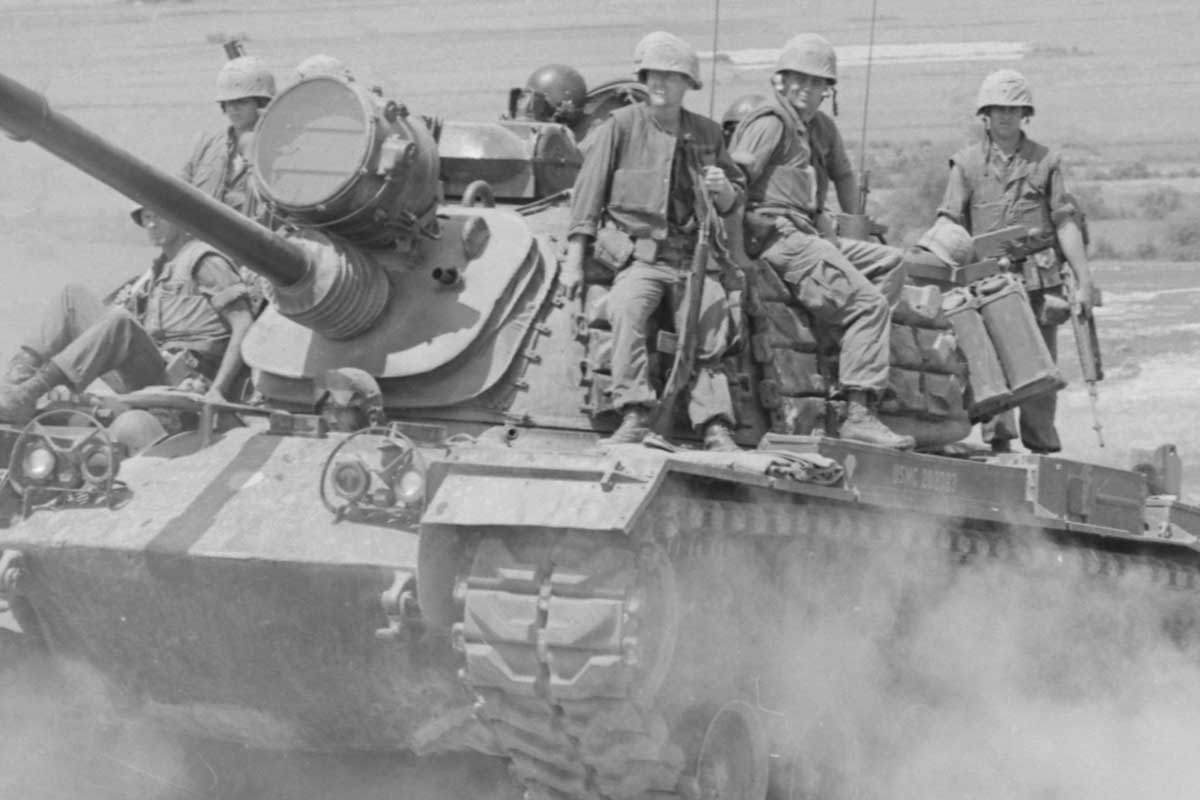
In April 2003 the U.S. Army's 3rd Infantry executed a high speed convoy attack into the heart of Baghdad, using heavy weapons, armored vehicles and explosive speed to scatter and overcome the Iraqi defenders.
This raid-style tactic quickly became known as the 3rd Infantry's "Thunder Run," dramatically capturing much of the city with few losses and little resistance.
But while it may be an apt description, the original 'thunder run' was in some ways a lot less dramatic but a whole lot more dangerous.
During the Vietnam War, the Viet Cong (VC) and North Vietnamese Army (NVA) used land mines extensively, either in ambushes, booby traps or more conventional tactics, such as along roadsides. The United States and its allies didn't have much at the time that could mitigate the landmine threat.
One pamphlet at the time said so many mines were used so effectively by the Viet Cong that the war was called a "War of Mines and Booby Traps." In fact, 75% of combat vehicles were lost to mines in Vietnam.
During the 1960s and 1970s, clearing roads of mines and taking down minefields was a slow, deliberate and laborious process. Individual soldiers or Marines would have to walk down roads and other open terrain with metal detection equipment or other hand-held mine detection systems.
Some mine detection systems wouldn't even work if they couldn't detect the material from which the mines were made. Even the Army's Chief of Research and Development in Vietnam wrote that the mines "outstripped the capability of our counter systems to detect and destroy them. Vietnam has seen the emergence of mines as a major weapons system, used on a scale, relatively speaking, never before encountered."
And when a mine was detected, extracting or removing it was also a slow, careful process -- and that's just what the VC and NVA wanted.
If not a part of an ambush, the Communists used land mines as part of an effort to slow down the U.S. or South Vietnamese advances into the North or around the demilitarized zones. An entire convoy, for example, could be halted by the use of landmines.
As the troops and trucks backed up waiting for the mines to be cleared, they made a more and more tempting target as the wait grew longer and the size of the backup grew bigger. The Americans and their allies needed a better, faster way.
Enter the M-48 Patton tank.
The U.S. arsenal didn't have a lot that could withstand the blasts from the Communists' most powerful landmines. The M-48 Patton could, and as such were given a new infantry support mission: minesweeping.
Areas along Highway 19 in Vietnam's Central Highlands were home to a number of support bases built by U.S. Special Forces and the Army of the Republic of Vietnam (ARVN, or South Vietnam). The bases were supposed to stem the flow of troops and supplies coming from the North.
Communist forces, knowing that Highway 19 was the road used by U.S. and ARVN supply convoys, would take to mining the road, cutting off supplies to other areas critical to American war plans, especially the city of Pleiku.
And to expedite the de-mining of the road, the 11th Armored Cavalry devised a faster means of clearing mines: the Thunder Run.
Two M-48 Patton tanks would go down either side of the road, headed in the same direction. With one track on the road and the other track on the shoulder, the tanks quickly drove to a predetermined point in the road, all guns blazing. If they didn't hit a mine, the road was considered clear.
If the Pattons did hit a mine, the damage was considered minimal. If they had to stop at all, it was only to replace one or two wheels along the tank's tracks. It was much faster than spending all day waiting for a handful of soldiers to clear the stretch of road.
The tanks were used on all-night road marches, using the main turrets and the machine guns aboard the tank. This also triggered any preset ambushes along the roads. Highway 13 from Phu Cuong to Loc Ninh even became known as "Thunder Road" because of the frequency
of the tactic used to trigger night ambushes.
While the U.S. Army's 2002 report on Mounted Combat in Vietnam acknowledged the mileage and strain put on the M-48 tanks from the use of Thunder Run tactics, it was considered indispensable to saving infantrymen from mines and ambush tactics along the highways.
-- Blake Stilwell can be reached at blake.stilwell@military.com. He can also be found on Twitter @blakestilwell or on Facebook.
Want to Learn More About Military Life?
Whether you're thinking of joining the military, looking for post-military careers or keeping up with military life and benefits, Military.com has you covered. Subscribe to Military.com to have military news, updates and resources delivered directly to your inbox.
© Copyright 2020 Military.com. All rights reserved. This material may not be published, broadcast, rewritten or redistributed.
"original" - Google News
October 30, 2020 at 01:19AM
https://ift.tt/3jMdTio
The Original 'Thunder Run' Was a Way to Clear Minefields - Military.com
"original" - Google News
https://ift.tt/32ik0C4
https://ift.tt/35ryK4M
Bagikan Berita Ini














0 Response to "The Original 'Thunder Run' Was a Way to Clear Minefields - Military.com"
Post a Comment